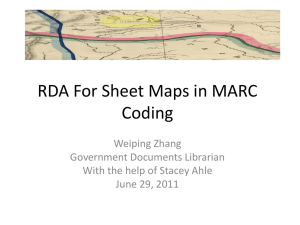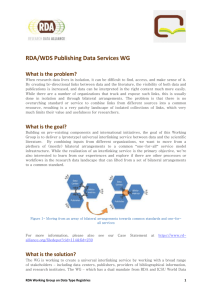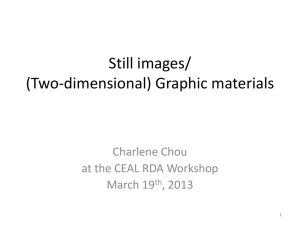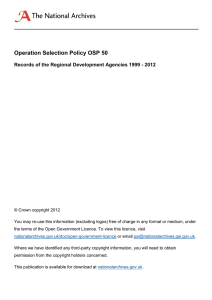REGIONAL DEVELOPMENT AGENCIES: EUROPEAN
advertisement
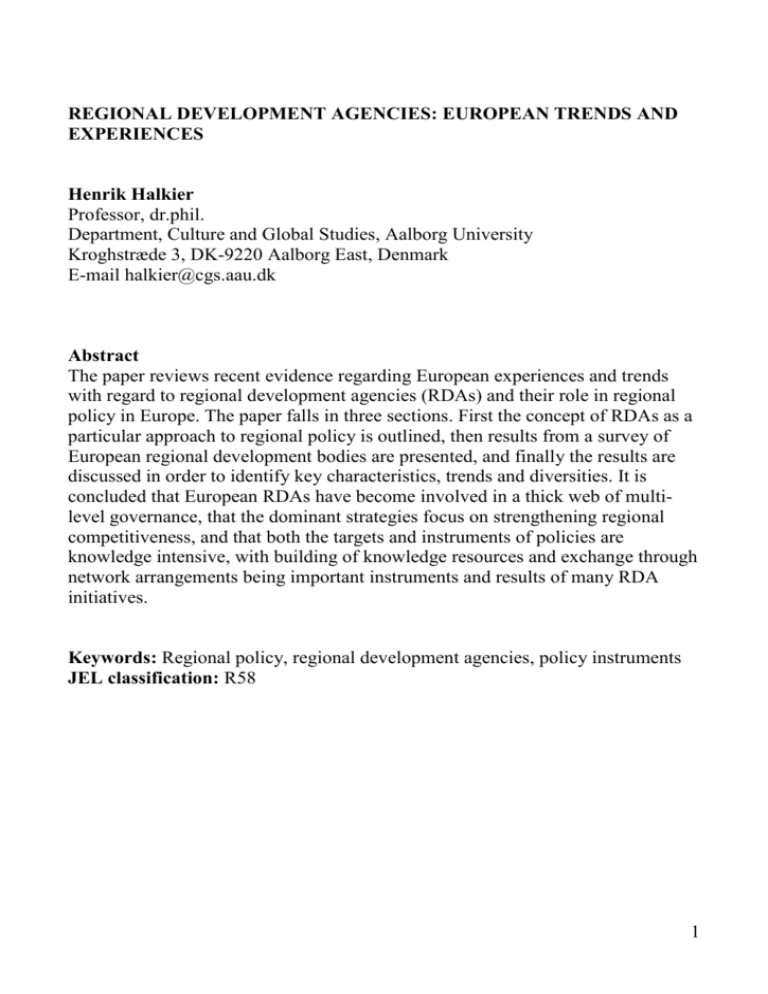
REGIONAL DEVELOPMENT AGENCIES: EUROPEAN TRENDS AND EXPERIENCES Henrik Halkier Professor, dr.phil. Department, Culture and Global Studies, Aalborg University Kroghstræde 3, DK-9220 Aalborg East, Denmark E-mail halkier@cgs.aau.dk Abstract The paper reviews recent evidence regarding European experiences and trends with regard to regional development agencies (RDAs) and their role in regional policy in Europe. The paper falls in three sections. First the concept of RDAs as a particular approach to regional policy is outlined, then results from a survey of European regional development bodies are presented, and finally the results are discussed in order to identify key characteristics, trends and diversities. It is concluded that European RDAs have become involved in a thick web of multilevel governance, that the dominant strategies focus on strengthening regional competitiveness, and that both the targets and instruments of policies are knowledge intensive, with building of knowledge resources and exchange through network arrangements being important instruments and results of many RDA initiatives. Keywords: Regional policy, regional development agencies, policy instruments JEL classification: R58 1 1. Introduction Regional development agencies (RDAs) have come to play an increasingly prominent role in attempts to promote economic development in regions across Europe and the world at large (Halkier and Danson, 1997, Danson et al., 2005, Pike et al., 2006, Halkier, in print). Firstly, it is widely recognised that the regional level offers a platform for public policy that is closer to the variable and specific conditions governing the prospects of private enterprises, but at the same time sufficiently distant from individual actors to avoid being captured by e.g. individual enterprises or local politicians. Secondly, creating a public body outside the mainstream government apparatus is an organisational design that can help regional development activities to be situated closer to the concerns of private sector actors and at the same time to sheltered from both day-to-day political pressures and therefore able to take a more long-term strategic approach to regional development. Thirdly, these two features make RDAs eminently suitable for becoming involved in regional policy activities of a programmatic nature like the European Structural Funds, and as the importance of the European level in regional development has increased significantly since the late 1980s, the growing role of RDAs in and beyond the current borders of the EU undoubtedly owes a lot to the adoption of a long-term programming approach within the Structural Funds. Despite current discussions about the future of Cohesion policy (European Union, 2011, Bachtler et al., 2009), in the European part of the world, RDAs are here to stay. This could, however, mean many different things, because previous research has demonstrated a great deal of variation between European RDAs (Halkier and Danson, 1997, Halkier et al., 1998), and it has even been argued that “the model is broken” and there is no longer typoe of ‘model RDA’ that is being aimed for by regional policy-makers (Danson et al., 2005). At a time when new RDAs continue to be established in e.g. Turkey (Lagendijk et al., 2009, Frantz, 2008, Dulupcu, 2005, Lowendahl-Ertugal, 2005), it can therefore be useful to review recent evidence regarding European experiences and trends with regard to RDAs and their role in regional policy in Europe. The paper falls in three sections. First the concept of RDAs as a particular approach to regional policy is outlined, then results from a survey of European regional development bodies are presented, and finally the results are discussed in order to identify key characteristics, trends and diversities. 2 2. RDAs and regional policy: Ideal-types and multi-level realities In the academic literature RDAs have been defined as a regionally based, publicly financed institution outside the mainstream of central and local government administration designed to promote indigenous economic development through an integrated use of predominantly ‘soft’ policy instruments (Halkier and Danson, 1997) and their role in regional policy has often been defined in opposition to traditional central government measures, as illustrated by Table 1. Table 1 Regional policy approaches compared Key features Top-down Bottom-up Organisation National designation Regional designation Departmental Semi-autonomous Redistribution of growth Strengthen indigenous growth Increase economic hardware Improve economic software/orgware ‘Hard’ resources ‘Hard’ and ‘soft’ resources Non-selective, reactive Selective, proactive Strategies Policy instruments Source: Reworked from Halkier 2006 Table 2.2, Halkier in print, cf. Halkier & Danson 1997. Top-down regional policies, prominent in Western Europe from 1960s through to the late 1980s, were attempts by central government to promote equality between regions by redistributing economic activity to problem areas by means of a system of ‘carrots’ and ‘sticks’, primarily relying on ‘hard’ policy instruments such as infrastructure and financial subsidies in order to boost economic hardware in the designated regions through increased investment. In contrast to this bottom-up regional policies have been conducted within individual regions, principally aiming to improve the competitiveness of indigenous firms in order to address the specific problems of individual localities, often through ‘soft’ policy instruments such as advice, networks, or training was aimed at improving economically relevant knowledge (software) and knowledge exchange (orgware). Moreover, within the bottom-up approach responsibility for regional policy frequently 3 moved away from government departments and instead vested in semiautonomous public bodies with responsibility for development and implementation of economic development initiatives – in other words, RDAs became the organisational vehicle through which bottom-up regional policy were developed and implemented. Bottom-up regional policy as embodied by RDAs in Table 1 is a Weberian ideal type with plenty of scope for variation, and historically the two policy approaches co-existed in nations and regions across Europe (Bachtler, 1997, Halkier, 2006). Moreover, especially within the European Structural Funds have the two approaches merged in the sense that top-down selection of areas designated for regional support has been combined with extensive involvement of regional-level bodies in the implementation of regional development programmes to the extent that it can be argued that the EU policies themselves have been one of the main drivers of the emergence of RDA-type organisations in both old, new – and indeed prospective – member states (Östhol et al., 2002, Lowendahl-Ertugal, 2005, Bachtler and McMaster, 2008). Individual development bodies can in other words be expected to combine general and specific characteristics (Halkier, 2012): general pressures embodied in the EU Structural Funds point towards homogeneity with regard to governance patterns and general strategic goals, while national regulations and the need to address specific development challenges of individual regions points towards divergence in terms of governance, policy targets and instruments. In order to identify key characteristics of regional-level economic development bodies in EU member states, an empirical survey of regional development bodies in Europe was undertaken in 2006/2007 as part of the EURODITE project sponsored by the 6th Framework Programme of the EU. The survey covered 22 member states, and in each of these a web-based survey focused on the most important organisation at the most important meso-level. Of the 273 organisations identified as potential objects of investigation, around one-third of these proved to have only rudimentary websites or to be inaccessible to the language skills of the researchers, and eventually a total number of 181 organisations were included in the survey, as illustrated by Figure 1.1 For each organisation a range of characteristics corresponding to the key features included in Table 1 were identified, including data relating to its four most important policies. Although clearly selective by restricting the focus to one organisation at one intermediate 1 For a full list of the organisations surveyed, see Halkier 2012. 4 3/19 20/21 4/15 4/5 2/10 6/6 12/12 10/12 4/4 7/14 16/16 7/11 6/13 2/8 9/9 5/7 17/17 6/11 6/16 15/15 12/20 8/12 Figure 1. RDAs surveyed (actual/potential). Source: RDA survey database. level of governance, the survey is still the most extensive systematic survey of regionally-based economic development activities undertaken on a Europe-wide basis, and through comparison with the results of an earlier, much more smallscale, research of a similar nature undertaken in the mid-1990s (Halkier and Danson, 1997), it may even be possible to identify changes occurring in recent decades. While some of the organisations included in the survey may turn out not to comply fully with the academic definition of an RDA, for the sake of brevity the organisations surveyed will, however, be referred to collective as RDAs in the following analysis. 3. Regional policies: Key dimensions Organisation and strategies The organisational context of the regional development body concerns the relation between the RDA and its political and financial sponsors within and/or outside the 5 region. This describes its freedom of action in terms of being able to decide on the aims and methods in promoting regional development, and the resources at its disposal to translate strategies into implemented policies. In terms of sponsorship it could be expected that RDAs would be primarily be sponsored by regions, but, as illustrated by Figure 2, this is the case for less than half the organisations surveyed, while central government is the sole sponsor for nearly 20 per cent of the RDAs for which sponsorship data was available. Interestingly, multiple sponsorship characterises no less than 40 per cent of the organisations, and as this conclusion is in line with the results of an earlier smallscale pilot study of the situation in the early 1990s (Halkier and Danson, 1997), multi-level governance would appear to have become a prominent and permanent feature in the current governance of regional economic development. Multi Arm'slength/plural Local Arm'slength/dominant Arm'slength/single Central Semidepartmental Regional Departmental 0 20 40 60 80 0 Figure 2. Sponsors of RDAs. Number of organisations (N = 178). Source: RDA survey 2007 database. 20 40 60 80 Figure 3. Sponsorship relations of RDAs. Number of organisations (N = 165). Source: RDA survey 2007 database. For the vast majority of organisations for which data was available, the relation between the RDA and its political sponsors could be characterised as arm’slength, i.e. that the sponsor only oversees development in general terms and leaves considerable discretionary powers with regard to strategic initiatives and implantation to the development body itself. As illustrated by Figure 3, the number of arm’s-length sponsors varies, and this is likely to affect the RDA’s room for manoeuvre, because one or few sponsors being more likely to wield detailed influence and ‘shorten the sponsorship arm’. Still, a sizeable minority of organisations are directly incorporated into the administrative structures of mainstream government, albeit in most cases somewhat sheltered in a semidepartmental position through the presence of e.g. a separate (advisory) board of directors, and thus from an organisational perspective around 15 per cent of the 6 regional development bodies surveyed do not comply with the original definition of RDAs. With regard to individual policy initiatives it is, however, also worth noting that nearly half of the policies for which data was available were sponsored by supraregional levels of government, as illustrated by Figure 4. This implies that although the RDA had been established to promote development within a particular region, a significant part of its activities involved implementing policies that to a greater or lesser extent had been designed elsewhere to address issues of national or European concern. Multiple Figure 4. Sponsorship of RDA policies. Number of policies (N=421). Source: RDA survey 2007 database. EU National/EU National Regional/national Regional 0 50 100 150 200 250 Strategies and policy targets Regional development bodies across Europe from being almost unison in terms of their objectives, both in terms of their overall corporate goals and the aims associated with individual policy initiatives: the competitiveness-oriented EU Lisbon strategy has clearly established what could be termed discursive hegemony, and at least in terms of how the aims of regional policy are being talked about, this differs from the situation in the early 1990s where equalityoriented goals like employment creation/safeguarding accounted for more than a quarter of the, admittedly much smaller, sample (Halkier and Danson, 1997). 7 450 400 350 300 250 Figure 5. RDA policy targets. Number of policies (N = 692). Source: RDA survey 2007 database. 200 150 100 50 0 Persons Organisations Hardware Software System Orgware In order to characterise the policies in greater detail we now consider the targets of regional policy in order to establish how strategic aims are translated in concrete objectives for change, i.e. who/what is going to change in which way as a result of public intervention in order for the policy measure to achieve its aims. Figure 5 charts the changes in capabilities sought – material, immaterial or organisational – in relation to different types of institutional targets. Although many policies target more than one capability/institution and this can lead to an overestimation of the importance of especially some of the less common targets, it is immediate clear obvious that organisations – most often private firms – remain by far the most important institutional target of regional policy in European regions, and also that the capacity most often targeted relates to software, i.e. boosting the economically useful information available. It is, however also noticeable that both training of individual persons and various system-level measures (infrastructure, cluster formation) also play a significant role, and, indeed, that around a quarter of all the measures targeting firms actually attempt to improve their orgware, e.g. by encouraging them to participate in networks with other firms or knowledge institutions. Compared to the, albeit much smaller, survey of RDAs undertaken in the 1990s (Halkier and Danson, 1997), the two most important changes are clearly the increased importance of training of the potential/present workforce and, not least, the explosive growth in networkoriented measures from the 1990s onwards. Policy instruments The policy instruments used to bring about change combine resources and rules: in order to make actors behave in ways conducive to policy goals, resources are 8 made available on more or less stringent conditions. As illustrated by Figure 6, only 6 of the 12 basic policy instruments have been used by the RDAs surveyed to promote regional development, and the patterns of absence are unambiguous: no policy instruments relying on authority as its primary resource or prescribing mandatory used of other resources were in evidence. What is equally striking, however, is the fact that the direct transfer of financial resources plays a relatively limited role, although of course the unconditional availability of resources does in itself automatically entail a significant indirect financial subsidy. The main instruments of European RDAs are therefore now clearly organisational and informational resources made available either conditionally and unconditionally, and perhaps unsurprisingly given the importance of software as the main target of capacity change (cf. Figure 5), information is the most important policy resource. Furthermore, it is common for individual policies to combine different policy rules by making some resources available unconditionally while other, presumable more complex or ‘advanced’, resources are only available if firms meet certain conditions, e.g. sign up to participate in more extensive interactions with the RDA or undertake to invest some of their own resources in particular ways – in fact more than two-thirds of the policies surveyed entail both unconditional and conditional access to resources in other to influence the behaviour of economic actors within their region. RDAs and their regional context The individual RDAs in the survey operate in policy environments where other public bodies also pursue regional development goals, and therefore the relationship between different economic development bodies is important in its own right because different patterns of cooperation and competition between them may be more or less conducive to achieving the shared goal of regional 600 500 400 Figure 6. RDA policy instruments. Number of policies (N = 692). Source: RDA survey 2007 database. 300 200 100 0 Mandatory Authority Finance Conditional Information Unconditional Organisation 9 development. The web-based survey was chosen as research design in order to be able to cover regions across Europe, but obviously this approach is not well-suited to capture in any great detail the relationship between the RDAs surveyed and the policy environment in which they operate. In order to get a preliminary idea about the balance between complementary and overlapping policies within individual regions, a comprehensive survey of economic development bodies and activities in twelve regions have been undertaken, using the same conceptual framework and similar methods as the main European survey.2 The main difference between the two samples concerns sponsorship; here the dominance of multiple sponsor arrangements in the regional survey is in reality a reversal of the dominance of single-sponsor agencies in the European survey, something which further underlines the importance of multi-level governance patterns in regional economic development in Europe. While the activities of the average development body in the regional survey is quite similar to the average RDA identified in the European survey, the division of labour within each region may still take different forms: at one extreme all the organisations have similar profiles and support the same kind of activities in similar ways, mutually supporting or competing against each other, and at the other extreme all the organisations have different profiles that complement each other and constitute a well-defined division of labour. For each of the twelve regions a comparison has been undertaken between the RDA included in the European survey on the one hand, and the development bodies and activities covered in the regional survey on the other. Perhaps unsurprisingly, the coexistence of many regional development bodies generally increases the diversity of policy activities in the individual region so that a greater variety of targets are aimed for with a wider range of policy instruments and eventually bring about more heterogeneous knowledge implications. Complementarity is particularly pronounced with regard to sponsorship, cf. Table 2, something which could indicate that the sponsors of the main RDA within a region are less likely to establish parallel organisations than to enter into joint sponsorship arrangements with other actors. Conversely, the difference between the two samples is least 2 The in-depth regional survey was undertaken by partners in the EURODITE project which also sponsored the European survey. In each of the 12 regions the following regional development activities were surveyed: the most important European and national programmes, as well as the four most important policies of the four most important regional or local development bodies. 10 pronounces with regard to policy targets where a high degree diversity can be seen in most regions, as illustrated by Table 3. Table 2. European and regional survey results compared: Sponsorship. Relative prominence of characteristics within regions (red dots for European survey, blue dots for regional survey). Regional Central Local Multi GE Baden-Württemberg ●●● ●● ●●●●● ●● GE Bayern ●●●●●● ●● ●● GE Niedersachsen ●●● ●●● GE Nordrhein-Westphalen ●●● ●● ●●● ●●● DK Bornholm ●●● ●●● DK Nordjylland ●●● ●●● ●● ●●● ES Catalonia ●●●●● ●● ●●●●●● FR Aquitaine ●● ●● ●●●●●● NL Gelderland ●●● SE Skåne ●●● ●●● ●●● SE Västra Götaland ●●● ●● ●●● UK West Midlands ●●●●● Source: RDA survey 2007 database. Table 3. European and regional survey results compared: Target capabilities. Relative prominence of characteristics within regions (red dots for European survey, blue dots for regional survey). Hardware Software Orgware ●●●● ●●●● GE Baden-Württemberg ●●●● ●●●●●● ●●●●● GE Bayern ●● ●●●●● ●●●●● GE Niedersachsen ●●● ●●●●●● GE Nordrhein-Westphalen ●●● ●● ●●●●●● DK Bornholm ●● ●●● ● ●●●●●● DK Nordjylland ●●●● ● ●●●●●● ES Catalonia ●●●●● ●●● ●●●● FR Aquitaine ●●●●●● NL Gelderland ●●●●● ●● ●●●●● ●●●●●● ●●●●● SE Skåne ● SE Västra Götaland ●●●● ●● ●●●●● ●●●●● ●●●●● UK West Midlands ●● Source: RDA survey 2007 database. 11 4. Conclusions and perspectives Surveying RDAs across the EU in a diversity of regional contexts in terms of governance, policies and (knowledge) economic development has produced a clear picture of the current profile and long-term trends in bottom-up regional policy in Europe. A picture that may be deepened through even more extensive surveys and in-depth case studies, but which nonetheless makes it possible to draw conclusions. An important finding of the survey is the fact that multi-level governance of bottom-up regional policy now has become widespread so that most individual development bodies and/or their activities are sponsored by several tiers of government rather than simply by e.g. the region itself. This, in turn, has further strengthened the arm’s-length principle so that RDAs, at least from an institutional perspective, operate as semi-autonomous entities outside mainstream government. Taken together this implies that a new generation of regionally based development bodies, networked RDAs, has become a conspicuous feature in regional policy in Europe. In terms of strategies, the objectives of regional development is now firmly based in Lisbon-style competitiveness-oriented discourse, and while private firms remain the most common target, targeting individuals through e.g. training measures has grown in importance, along with the now dominant focus on bringing about change in software and orgware. In short, also regional policy measures themselves have acquired a conspicuous network dimension, with a focus on stimulating inter-firm relations and relations between firms and public knowledge institutions in e.g. clusters. In the light of this it is hardly surprising that the policy instruments employed by European RDAs are dominated by the use of informational and organisational resources, and thus the vast majority of policies are of a knowledge-explicit and knowledge-intensive character, i.e. either their targets of change or the policy instruments involved required detailed knowledge of particular firms and areas of economic activity. In terms of the knowledge impact of RDA policies, exploitation of synthetic (business, engineering) knowledge predominates, although symbolic (marketing) knowledge is also clearly a secondary focus. All in all the survey documents the spreading of a new-model bottom-up regional development policy which appears to be well in tune with the Lisbon visions for a 12 competitive European knowledge economy. This change in regional policy has, however, also occasionally received more sceptically, because of what is no longer in focus such as e.g. transfer of economic resources (e.g. Hudson, 1997), and because of unease about the transferability of practices to less well-off regions and the risk of importing practices without sufficient adaptation to local circumstances (MacLeod, 2000, Hassink, 2001, Hassink, 2005, Rutten and Boekema, 2007, Lagendijk, 2000, Markusen, 1999). These issues are, however, difficult to address through surveys like the current one but require in-depth case studies and evaluation-type research to illuminate, but still it is possible to identify some key implications of the current policy profile of European RDAs. In terms of governance the key finding of the survey was that currently RDAs are operating in a network environment, mostly with a plurality of sponsors for the organisation as such and/or its policy activities. On the one hand this poses the strategic challenges of maintaining the overall direction of activities with different sponsors promoting different development agendas and activities, and with ensuring the integrated policy delivery that has traditionally been one of the arguments for using multi-functional bodies to stimulate regional economic development. On the other hand it poses the organisational challenge of having staff capable of operating effectively in such an environment where it is no longer enough to ‘know your stuff’ and be able to deal with individual clients but you also need to ‘get along’ with parallel/competing organisations in order to make things moving in the direction desired. With regard to regional development strategies, two findings were particularly conspicuous: the limited role of direct financial subsidies as policy instruments, and the predominance of knowledge-explicit policies. The former may reflect a distribution of labour between development organisations - in some countries financial subsidies are always handled by governmental organisations rather than semi-autonomous bodies like RDAs - and so the challenge is one of coordination between organisations, if, of course, grant aid is available from other sources. The challenge of the latter is, however, crucial because the pivotal role of knowledge with regard to both policy targets and instruments increase the demands on RDAs to have access to relevant knowledge resources, either in-house or through their network to public and private providers. Taken together current and future challenges for RDAs can be captured in the catch-phrase ‘better and more knowledge-intensive networking’ in order to be able to act as agents of change in the regional knowledge economy. A role that 13 underlines the character of modern RDAs as ‘network nodes’ rather than ‘monopolistic implementers’ of regional development initiatives, where successful performance will require not only good working relationships with private-sector clients but also fruitful interaction with private providers of business services and public knowledge institutions such as universities. Bibliography Bachtler, J. (1997) 'New Dimensions of Regional Policy in Western Europe', in Keating, M. & Loughlin, J. (Eds.) The Political Economy of Regionalism. London, Frank Cass. Bachtler, J. & Mcmaster, I. (2008) 'EU Cohesion policy and the role of the regions: Investigating the influence of Structural Funds in the new member states', Environment & Planning C: Government and Policy, 26, 398-427. Bachtler, J., Mendez, C. & Wishlade, F. (2009) 'Challenges, Consultations and Concepts: Preparing for the Cohesion Policy Debate', EoRPA Paper, 09. Danson, M., Helinska-Hughes, E. & Hughes, M. (2005) 'RDAs and Benchmarking: Learning from Good Practice when the Model has Broken', Public Policy and Administration, 20, 4-22. Dulupcu, M. A. (2005) 'Regionalisation for Turkey - An Illusion or a Cure?' European Urban and Regional Studies, 12, 99-115. European Union (2011) 'Investing in Europe's future - Fifth report on economic, social and territorial cohesion', Brussels, European Union. Frantz, M. D. (2008) 'The Potential for Effective Regional Development Agencies in Turkey: A Comparative Analysis', Regional & Federal Studies, 18, 375402. Halkier, H. (2006) Institutions, Discourse and Regional Development. The Scottish Development Agency and the Politics of Regional Policy, Brussels, PIE Peter Lang. Halkier, H. (2012) 'Regional Development Agencies, Regional Policy and Knowledge Dynamics', in Bellini, N., Danson, M. & Halkier, H. (Eds.) Regional Development Agencies: The Next Generation. Abingdon, Routledge. Halkier, H. (in print) 'Knowledge Dynamics and Policies for Regional Development: Towards a New Governance Paradigm?' European Planning Studies. 14 Halkier, H. & Danson, M. (1997) 'Regional Development Agencies in Europe: A Survey of Key Characteristics and Trends', European Urban and Regional Studies, 4, 243-56. Halkier, H., Danson, M. & Damborg, C. (Eds.) (1998) Regional Development Agencies in Europe, London, Jessica Kingsley Publishers. Hassink, R. (2001) 'The Learning Region: A Fuzzy Concept or a Sound Theoretical Basis for Modern Regional Innovation Policies?' Zeitschrift für Wirtschaftsgeographie, 45, 219-30. Hassink, R. (2005) 'How to Unlock Regional Economies from Path Dependency? From Learning Region to Learning Cluster', European Planning Studies, 13, 521-35. Hudson, R. E. A. (1997) 'Developing Regional Strategies for Economic Success: Lessons from Europe's Economically Successful Regions', European Urban and Regional Studies, 4, 365-73. Lagendijk, A. (2000) 'Learning in Non-core Regions: Towards "Intelligent Clusters" Adressing Business and Regional Needs', in Rutten, R. (Ed.) Learning Regions: Theory, Policy and Practice. London, Edward Elgar. Lagendijk, A., Kayasu, S. & Yasar, S. (2009) 'The role of Regional Development Agencies in Turkey: From Implementing EU directives to Supporting Regional Business Communities?' European Urban and Regional Studies, 16, 383-96. Lowendahl-Ertugal, E. (2005) 'Europeanisation of Regional Policy and Regional Governance: The Case of Turkey', European Political Economy Review, 3, 18-53. Macleod, G. (2000) 'The Learning Region in an Age of Austerity: Capitalising on Knowledge, Entrepreneurialism, and Reflexive Capitalism', Geoforum, 31, 219-36. Markusen, A. (1999) 'Fuzzy Concepts, Scanty Evidence, Policy Distance: The Case for Rigour and Policy Relevance in Critical Regional Studies', Regional Studies, 33, 869-84. Pike, A., Rodriguez-Pose, A. & Tomaney, J. (2006) Local and Regional Development, Abingdon, Routledge. Rutten, R. & Boekema, F. (Eds.) (2007) The Learning Region. Foundations, State-of-the Art, Future, Cheltenham, Edward Elgar. Östhol, A., Svensson, B. & Halkier, H. (2002) 'Analytical Framework', in Östhol, A. & Svensson, B. (Eds.) Partnership Responses - Regional Governance in the Nordic States. Stockholm, Nordregio. 15



